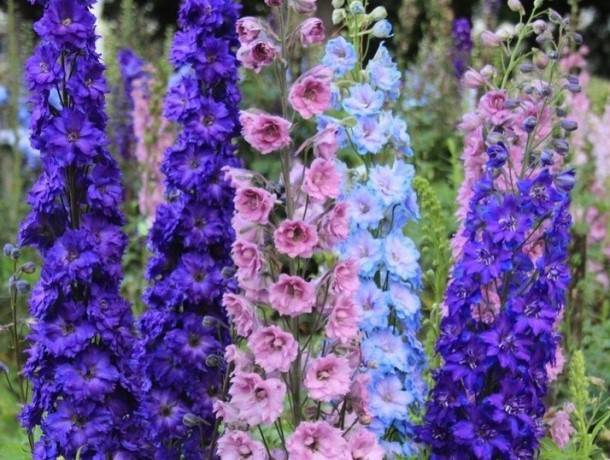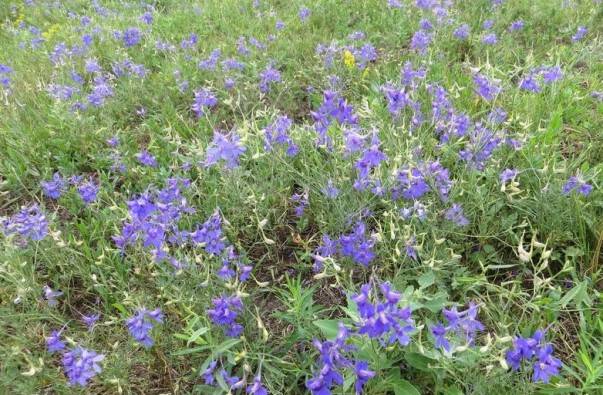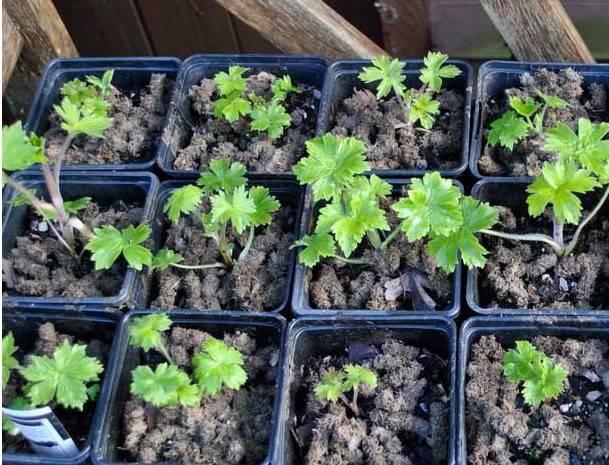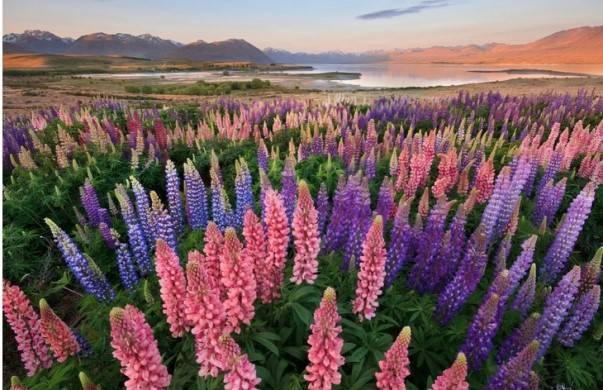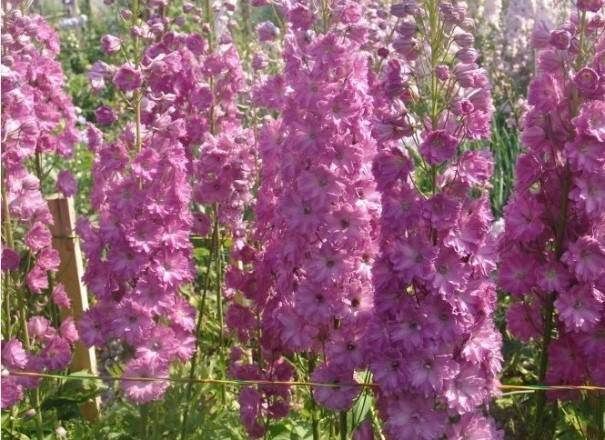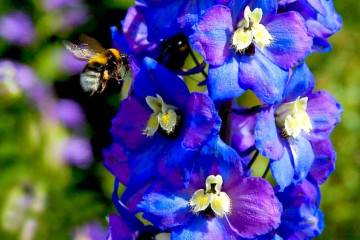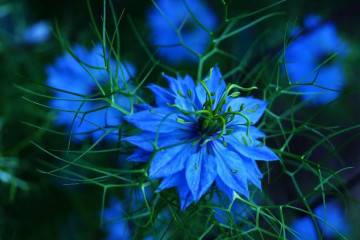Annual delphinium - field, wild, large-flowered
Content:
Delphinium annual is popular with landscape designers. Long slender stems are dotted with purple, red, blue flowers. The plant, from afar, highlights the area with bright flowering. About 40 varieties of this crop are grown in the temperate zone.
Delphinium annual or field larkspur
The wild-growing form of the annual delphinium can be called the larkspur. Another name - the spur plant received for the special shape of the petals, which have bends at the ends in the form of spurs.
The plant is found wild in the meadows of the northern hemisphere. The shrub rises above the herbs, stands out with a set of all kinds of colors. The plant prefers fertile soil, lives on slopes, along river banks, in shaded forest glades.
The origin and appearance of annual delphiniums
The species belongs to the family of buttercups. Wild forms served as material for the development of new cultivars.
The history of the plant's name has several versions. According to the first, the word delphinium is formed from the similarity of the shape of the bud with the head of a dolphin. Another opinion says that the name is a modified word for Delphi - a city in the vicinity of which culture grows in abundance.
Delphinium wild
Depending on the light and soil composition, the wild delphinium can grow from 1 to 4 m in height. Leaves with serrated edges, up to 16 cm in diameter, are arranged alternately from the root to the top of the straight stem.
Flowers, consisting of 5 petals 1.5 cm long, are collected in loose clusters at the top of the shoots. The buds are dark purple, brown, blue.
Description of annual delphiniums
The shrub grows wild and in the landscape design of the European part of Russia, in the Alps. All species exhibit toxic properties and are used in folk and traditional medicine. The bright colors of the buds allow the plant to be used in decorating gardens.
Types and varieties of annual delphiniums
There are about 400 plant varieties in the world. All forms contain alkaloids that affect the central nervous system, negatively affect the work of the heart and intestines. Delphinium is recognized as a poisonous plant.
Breeders have developed many hybrids adapted to the cold climate of the middle lane. Now you can grow not only bushes with a natural purple shade of buds, but also with a yellow, two-color.
Popular varieties:
- Delphinium Pacific Black Knight is the most resistant to disease and cold winters of the Pacific species. It grows up to 180 cm, the inflorescence is a candle of flowers, up to a meter long. The buds are dark purple in color, semi-double, 7 cm in diameter.
- Delphinium Galahad blooms with white ears of fringed buds, the height of the bush is up to 180 cm. With proper care, the variety can bloom twice in the summer.
- Delphinium Black Knight is famous for its inky purple coloration of large flowers. Thanks to the enchanting coloring of the flowers, the variety got this name. The buds are densely covered with brushes up to 70 cm long.
- Delphinium Scottish has absorbed varieties with double flowers of various shades. This is the most popular hybrid variety among gardeners.
Field delphinium (Delphinium Consolida)
Delphinium Consolida deserves special attention. This annual is up to 70 cm high with a straight main stem, side shoots are formed alternately along the entire length of the plant. The leaves are very thin and long, reminiscent of dill branches. The flowers are dark purple and consist of 5 petals and a spur. The culture blooms from June to September.
Raw materials are used to treat muscle diseases, larkspur infusions are used in gardening to scare away aphids and flies.
Growing annual delphiniums
It will not be difficult to grow a plant from seeds.
The seed has good germination capacity. Seedlings are resistant to night temperature extremes. There are no other ways to grow a crop, so you need to master the technique of forcing sprouts from a seed.
Delphinium annual: growing from seeds
Seeds for sowing must be prepared in advance. You can use the seed that has ripened on the bushes from the last season. A variety of varieties can be found on garden store shelves.
A strong solution of potassium permanganate or fungicide is prepared, in which the seeds are soaked for 30 minutes. After that, you need to stimulate germination with a root former. After a day of stimulation, the seeds are dried.
When to plant seeds of an annual delphinium for seedlings
Growing an annual delphinium from seeds is done early. They begin to plant seedlings when the snow does not even think to melt - at the beginning of February.
After preliminary preparation, the seeds are sown in a nutrient substrate. The soil is prepared from leafy, sod land, sand, peat and humus in a ratio of 2: 2: 1: 2: 2. The earth is disinfected in the oven for 30 minutes. After that, delphinium can be sown into it.
Planting process:
- Shallow boxes are covered with 3 cm drainage from expanded clay or gravel.
- Fill the substrate with two-thirds of the volume of the container and compact it.
- The seeds are placed in the ground, spreading them evenly on the surface.
- Cover with soil 5 mm.
- Moisten the soil from a spray bottle, cover with a film and put in a dark place for germination.
After the appearance of the first shoots, the container with the planting material is transferred to a well-lit room. The temperature should be 22-26 ° C.
When the seedlings have 4 leaves, they are dived into separate containers. The pots are taken out to the balcony every day to harden the young plant.
Landing in open ground
The plant loves shaded areas, with good airflow. However, there should be no drafts in the garden. The soil should be fertile and loose. Loams of neutral acidity are suitable; if necessary, the earth is fertilized with humus.
In the bright sun, the petals of the delphinium burn out, the plant loses its varietal brightness.The shrub has a small rhizome, with strong gusts of wind, young bushes can be uprooted from the ground.
A flat area is suitable, in which moisture will not linger. This will save the roots from decay and the development of putrefactive bacteria in the crown.
Step-by-step planting process
The seedlings are planted in the ground after a constant above-zero temperature is established at night. The earth for planting is dug onto a shovel bayonet, leveled and holes are made at a distance of 40 cm from each other. One seedling is added to each groove without damaging the roots. The ground around the bush is trampled down and watered.
Sprouts that were fed during development indoors take root better. Young shoots of the delphinium, saturated with nutrients, adapt more quickly to the new soil and experience a lack of fertility.
Caring for annual delphiniums
After planting, the soil moisture is monitored and periodically fed. The elongated stems are tied to a support. As it grows, diseased and dry branches are pruned, the faded inflorescences are removed. The bushes are treated with insecticides against pests, among which there is a delphinium fly, spider mite, aphids, slugs.
Watering mode
Watering should be sparse, but abundant. Delphinium tolerates a short drought well, moisture is more frequent during dry periods. Water the bushes after the soil is completely dry. Water is poured exactly under the bush, trying to prevent moisture from getting on the leaves, this can lead to the development of putrefactive bacteria on the branches.
Moisturizing is carried out in the evening or early morning hours. During active flowering, the amount of moisture must be increased.
Top dressing
In early spring, while there is still snow, organic fertilizers are introduced into the soil - manure, chicken droppings. At the beginning of planting, the delphinium is fed with mineral supplements with a large proportion of nitrogen. Nitrogen compounds accelerate shoot growth, which is important at an early stage of crop development.
When the buds are tied, the bush is watered with a solution of potassium and phosphorus, nitrogen should be less, as it will inhibit flowering. The last dressing is carried out after flowering, minerals contribute to the setting of seeds.
Organic fertilizers are essential for long-lasting flowering. Without a spring organic bookmark, there will be no bright flowering bunches.
Delphinium-like flowers
In nature, there are flowers similar to delphinium, the main advantage of which is a bunch of lush flowers on the shoot. From the twins of the spur, one can distinguish levkoy, lupine, phytostegia, foxglove, lakonos.
Lupine and delphinium: what is the difference
You need to know what is the difference between lupine and delphinium, so as not to confuse these similar plants. Lupine - useful in agriculture, belongs to the legume family. It is not poisonous, the raw materials are fed to livestock. In larkspur and lupine bushes, the shape of the inflorescence resembles a giant flowering ear. This is why these two plants can be confused from afar.
You can distinguish bushes by the shape of flowers and leaves. In lupine, the buds consist of 2 petals, opened in the shape of a sail. A leaf with a brighter shade than a delphinium, like a fan. People often confuse these 2 cultures because lupine is a flower that looks like a delphinium from a distance.
Delphinium New Zealand
Delphinium New Zealand can grow in one place for up to 10 years, then a bush update is required. This artificially bred hybrid amazes with its exuberant and bright flowering. The variety is actively used in decorating rooms, bouquets. For the formation of inflorescences on a perennial delphinium, it should take 2 years from the moment the seedlings are planted in the ground.
Description of the plant
The perennial reaches 2 m in height, during flowering, almost the entire length of the stem is covered with flowers up to 10 cm in diameter. The buds cover the trunk so densely that the leaves are almost invisible. The plant blooms from June to August, if you cut off the faded inflorescences, you can achieve re-flowering in September.
The colors of New Zealand giant hybrids are monochromatic - pink, violet, red, white. There is a striped pattern, with a center of a different color from the rest of the petals.
Delphinium New Millennium Innosens is a New Zealand form of shrub up to 1.8 m tall. Blooming white flowers for 2 months. The shape of the petals is rounded, slightly twisted.
Delphinium Astolat
The fantasy of breeders knows no boundaries, the new hybrid delphinium Astolat perfectly demonstrates this with luxurious flowering. The brushes, strewn with flowers, resemble a masquerade dress, or fluttering butterflies over a bush.
The form was bred in the Netherlands, it feels great in the warm climate of the south of Russia. Delphinium has mastered the Crimean city of Kerch, Alushta, Krasnodar Territory.
Description of delphinium Astolat
The large-flowered delphinium strikes with its beauty from afar. The perennial bush can grow up to 2 m in height, has several erect stems, which are almost completely covered with double pink flowers with a dark center. The diameter of the opened bud reaches 5 cm. The plant blooms twice a summer. It prefers to grow in fertile soil, with good aeration and moisture, loves the sun, and is not susceptible to diseases and pests.
Varieties of delphinium favorably decorate the site, they can be in a group of different cultures and in single plantings. To create a striking accent in your landscape design, consider this tall blooming shrub.
